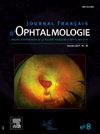Tomographie par cohérence optique-angiographie (Optical coherence tomography angiography (OCTA) et nerf optique (hors glaucome)
IF 1.1
4区 医学
Q3 OPHTHALMOLOGY
引用次数: 0
Abstract
La tomographie par cohérence optique-angiographie (optical coherence tomography angiography ([OCTA]) est un examen non invasif, fiable et reproductible. Contrairement à l’angiographie à la fluorescéine, l’OCTA permet d’analyser le lit capillaire sans être gêné par les phénomènes de diffusion. Son emploi est maintenant largement répandu pour le diagnostic et le suivi des maladies rétiniennes et choroïdiennes. Cependant, son usage dans l’exploration du nerf optique est encore limité. Récemment, l’arrivée de logiciels qui permettent une quantification des données, complètent les images de la vascularisation maculaire et papillaire. Cette revue expose les résultats obtenus en OCTA au cours de l’exploration des principales affections du nerf optique acquises ou congénitales en dehors de la neuropathie optique glaucomateuse. Dans la plupart des cas, l’OCTA montrent des modifications de la vascularisation rétinienne ou papillaire en corrélation avec l’atteinte des fibres nerveuses rétiniennes, de la couche des cellules ganglionnaires et la fonction visuelle. L’OCTA contribue à améliorer la compréhension physiopathologique des affections du nerf optique sans pouvoir encore préciser si ces modifications sont une cause ou une conséquence de la maladie. L’utilisation de l’OCTA est pertinente en neuro-ophtalmologie. Outre la détection et le diagnostic, l’OCTA pourrait être employé pour le suivi ou la surveillance des traitements mis en place.
Optical coherence tomography angiography (OCTA) is a non-invasive, reliable, repeatable exam. As opposed to fluorescein angiography, OCTA allows analysis of the capillary bed without interference from diffusion phenomena. It is now widely used for both the diagnosis and ongoing care of retinal and choroidal diseases. However, its use is still limited for evaluation of the optic nerve. Recently, new data quantification software can add value to macular and papillary vascularization images. This review details OCTA results in the most important optic nerve conditions, whether acquired or congenital, other than glaucoma. In most cases, OCTA shows modifications of the retinal or papillary vascularization systematically impacting retinal nerve fibers, ganglion cells layer and visual acuity. OCTA contributes to a better understanding of the pathophysiology of optic nerve disease without being able to specify yet whether the modifications cause or are caused by the disease. OCTA is particularly useful for neuro-ophthalmology. In addition to detection and diagnosis, OCTA can be used for follow-up and monitoring of treatment response.
光学相干断层扫描血管造影(OCTA)和光学神经造影(青光眼除外)
光学相干断层扫描血管造影(OCTA)是一种无创、可靠和可重复的检查。与荧光素血管造影不同,OCTA可以在不受扩散现象干扰的情况下分析毛细血管床。它现在被广泛用于视网膜和脉络膜疾病的诊断和监测。然而,它在视神经探索中的应用仍然有限。最近,数据量化软件的出现,补充了黄斑和乳头状血管化的图像。本文介绍了OCTA在探索青光眼以外的主要获得性或先天性视神经疾病时所获得的结果。在大多数情况下,OCTA显示视网膜或乳头血管化的变化与视网膜神经纤维、神经节细胞层和视觉功能的损害有关。OCTA有助于提高对视神经疾病的生理病理学理解,但目前还不能确定这些变化是疾病的原因还是后果。OCTA的使用与神经眼科有关。除了检测和诊断外,OCTA还可用于监测或监测现有的治疗方法。光学相干断层扫描血管造影(OCTA)是一种无创、可靠、可重复的检查。与荧光血管造影相反,OCTA允许在不干扰扩散现象的情况下分析毛细血管床。它现在被广泛用于视网膜和脉络膜疾病的诊断和持续护理。然而,它在评估视神经方面的使用仍然有限。最近,新的数据量化软件可以为黄斑和乳头状血管造影图像增加价值。这篇综述详细介绍了OCTA在除青光眼以外的最重要的视神经条件下的结果,无论是获得性的还是先天性的。在大多数情况下,OCTA显示视网膜或乳头状血管化的变化系统地影响视网膜神经纤维、神经节细胞层和视觉敏感度。OCTA有助于更好地理解视神经疾病的病理生理学,但还不能具体说明这些变化是由疾病引起的还是由疾病引起的。OCTA对神经眼科特别有用。除了检测和诊断外,OCTA还可用于治疗反应的随访和监测。
本文章由计算机程序翻译,如有差异,请以英文原文为准。
求助全文
约1分钟内获得全文
求助全文
来源期刊
CiteScore
1.10
自引率
8.30%
发文量
317
审稿时长
49 days
期刊介绍:
The Journal français d''ophtalmologie, official publication of the French Society of Ophthalmology, serves the French Speaking Community by publishing excellent research articles, communications of the French Society of Ophthalmology, in-depth reviews, position papers, letters received by the editor and a rich image bank in each issue. The scientific quality is guaranteed through unbiased peer-review, and the journal is member of the Committee of Publication Ethics (COPE). The editors strongly discourage editorial misconduct and in particular if duplicative text from published sources is identified without proper citation, the submission will not be considered for peer review and returned to the authors or immediately rejected.

 求助内容:
求助内容: 应助结果提醒方式:
应助结果提醒方式:


